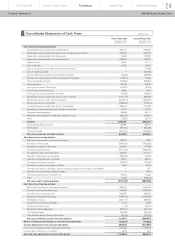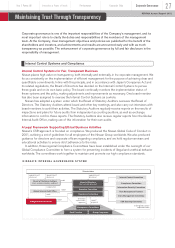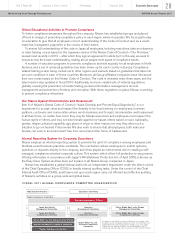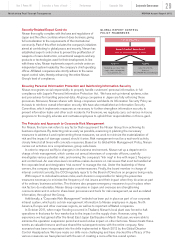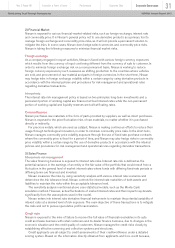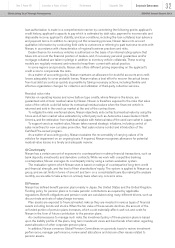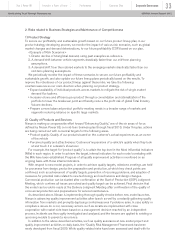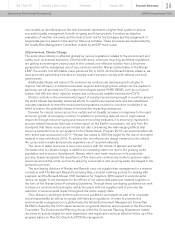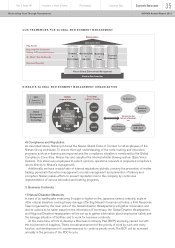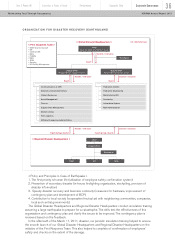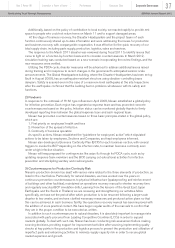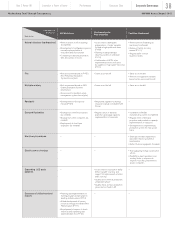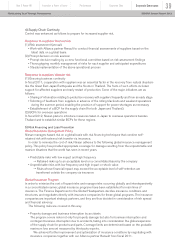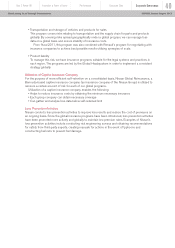Nissan 2012 Annual Report Download - page 34
Download and view the complete annual report
Please find page 34 of the 2012 Nissan annual report below. You can navigate through the pages in the report by either clicking on the pages listed below, or by using the keyword search tool below to find specific information within the annual report.
2. Risks related to Business Strategies and Maintenance of Competitiveness
1) Product Strategy
To secure our profitability and sustainable growth based on our future product lineup plan, in our
product strategy developing process, we monitor the impact of various risk scenarios, such as global
market changes and demand deteriorations, to our future profitability (COP) based on our plan.
<Example of Risk Scenarios>
1. Drastic decline of total global demand, using past examples as reference.
2. A demand shift between vehicle segments drastically faster than our mid-term planning
assumptions.
3. A demand shift from the matured markets to the emerging markets drastically faster than our
mid-term planning assumptions.
We periodically monitor the impact of these scenarios to secure our future profitability and
sustainable growth, and also update our future lineup plans periodically based on the results. To
improve the robustness of our product lineup against these risks, we take the following
countermeasures as our main direction when planning our product strategy.
• Expand availability of individual products across markets to mitigate the risk of single market
demand fluctuations.
• Increase volume and efficiency per product through a consolidation and rationalization of the
portfolio to lower the breakeven point and thereby reduce the profit risk of global Total Industry
Volume declines.
• Prepare a more balanced product portfolio meeting needs in a broader range of markets and
segments reducing reliance on specific large markets.
2) Quality of Products and Services
Nissan is making a companywide effort toward “Enhancing Quality,” one of the six areas of focus
defined by Nissan Power 88, our mid-term business plan through fiscal 2016. Under this plan, actions
are being carried out with numerical targets for the following areas.
• Product quality: Quality of our products based on the customer’s actual experiences as an owner
of the vehicle
• Perceived quality and attractiveness: Customers’ impressions of a vehicle’s quality when they look
at and touch it in a dealer’s showroom
For example, the target for “product quality” is to attain the top level in the Most Influential Indicators
(MIIs) in each region. In order to achieve the target, internal indicators for each model correlating with
the MIIs have been established. Progress of all quality improvement activities is monitored on an
ongoing basis with those internal indicators.
With respect to new model projects, in order to achieve quality targets, milestone meetings are held
for processes from design, production preparation and production, at which key check points are
confirmed, such as achievement of quality targets, prevention of recurring problems, and adoption of
measures for potential risks related to new technology and mechanisms and design changes.
Commercial production can be started after confirmation at the Start of Production (SOP) Judgment
Meeting, which confirms all issues are solved and quality target can be achieved. Final decision that
the model can be sold is made at the Delivery Judgment Meeting after confirmation of the quality of
commercial production and preparedness for service/maintenance.
As described above, Nissan is implementing thorough quality checks before new model launches.
Nissan is advancing quality improvement activities after launch as well by constantly gathering quality
information from markets and promptly deploying countermeasures if problems arise. In case safety or
compliance issues do occur, necessary actions such as recalls are implemented with close
cooperation with market side team based on a management decision reached by an independent
process. Incidents are thoroughly investigated and analyzed, and the lessons are applied to existing or
upcoming models to prevent a recurrence.
In addition to the above described activities, such as quality assurance at new model project and
quality improvement activities on daily basis, the “Quality Risk Management” framework has been
newly developed from fiscal 2009. While quality-related risks have been assessed and dealt with for
Innovation & Power of brandYear 2 Power 88 Performance Corporate Data
Corporate Governance 33
NISSAN Annual Report 2012Maintaining Trust Through Transparency



